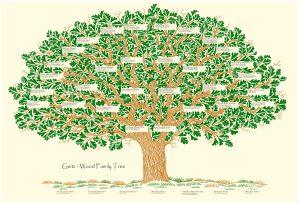Is it Genealogy or Ancestry?
Whether it is genealogy or ancestry makes no difference to most people researching their family tree – they are trying to trace relatives dating as far back as they possibly can. However, the two terms are different in significant way. Thus, you cannot trace your genealogy but you can trace your ancestry.
Genealogy and ancestry are related fields- in fact genealogy is the study of ancestry . Just as botany is the study of plants, ancestry is what you study, while genealogy is the name given to that study. Those who have an interest in genealogy can use that interest to study their ancestry, or those in their family who came before them. Such DNA tests have been carried out on countless historical figures; In fact there has been ancestry testing on Hitler, Marie Antoinette and the Russian Tzar.
You have two types of ancestor: those going down your father’s line (your paternal ancestors) and those going down your mother’s line (your maternal ancestors). You also have direct ancestors and collateral relatives.
Ancestry testing uses specific parts of your genetic code which are linked to out ancient ancestors- these will tell you about studied anthropological groups and migrations patterns of ancient ancestors.

Direct Ancestors and Collateral relatives
Your direct ancestors are those collectively responsible for your existence. Thus, although your aunt is your father’s sister, she was not responsible for your being, so she is known as a collateral relative. That is a relative that shares your blood to an extent, but is not in your direct lineage. Your grandfather, on the other hand, is a direct ancestor because had he not existed, neither would you have. Your grandfather was responsible for the birth of your father or your mother, each of whom who was in turn responsible for your birth.
When you research a family tree, you would generally start by tracing your direct ancestors. Once you have gone so far down your direct line, and have some experience in genealogy, you will be more capable of tracing your indirect ancestry, or collateral relatives. For some, just finding their direct ancestors is sufficient work, because that in itself can lead to quite a large family tree eventually, depending upon how far back you go.
For example, the two people directly responsible for your existence are your mother and father. Then one step below them are your four grandparents. If any of these four had never existed then neither would your mother or your father, and therefore, nor would you. Go one step below them and you have eight, then 16 then 32 and so on – just so that you were born! Imagine, then, the work involved in tracing your collateral ancestors: the brothers and sisters of the eight great-grandparents and then their children – and so on, and so on!
Genealogy Records
Genealogy records are those that can be used to determine your ancestry, and these two come in direct and indirect forms. The direct records are your ancestors’ birth certificates, created at the time of their birth, or other records created to show where they were at a specific time, such as the census records that are available for you to research. Secondary records for your existence include driving license records, marriage certificates and death certificates. They prove you were born, but not when or where you were born or where you lived at any time.
Where to Research Your Ancestry
Initially you should research the primary records of an ancestor’s birth. Records of all births and deaths (direct records of your ancestor’s death) are maintained by local authorities, and many are available online for a fee. You can also research indirect records in courthouses, parish churches, and local registries depending upon where you are. UK records go further back than those of the USA for example.
There are websites where you can find records of tombstone engravings, taxes paid and other transactions carried out in a parish that can be used to identify individuals. Census records are also available online – as far back as 1780 in the USA. Census records show who lived where on a specific date. Electoral rolls can show the permanent residence of ancestors on any date. There are many other sources of primary and secondary records available to enable more accurate genealogy to be carried out once you have the basic names and dates.
Irrespective of the semantics, many people use genealogy and ancestry as meaning the same thing: finding out who their ancestors were and building a family tree. They are more interested in the final result than the words used to describe it.

